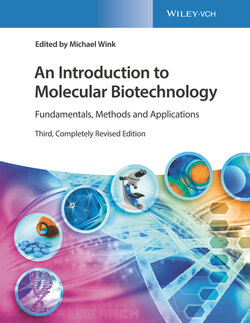Читать книгу An Introduction to Molecular Biotechnology - Группа авторов - Страница 24
3.1.1.2 Transport Processes Across Biomembranes
ОглавлениеThe properties of artificial lipid bilayers (Figure 3.4) also apply to biomembranes. Water and other small nonpolar molecules enter the cell by free diffusion. While cells possess additional specific water absorption mechanisms (aquaporins), they also need to take up polar and charged nutrients and to release waste products. Polar charged components include inorganic ions, sugars, amino acids, organic acids, nucleotides, and various other metabolites. As normal diffusion through the membrane would be too slow, the cell uses specific membrane proteins to speed up the process (Figure 3.5):
Ion channels or ion pumps for inorganic ions, above all Na+ channels, K+ channels, Ca2+ channels, and Cl− channels. More than 100 types of ion channels have been described. Ion channels exhibit ion selectivity and possess a sort of selectivity filter. Their activity can be modulated by voltage changes (voltage‐gated channel), by binding of ligands (ligand‐gated channel), and by mechanical stress (mechanically gated channel).
Transporters or carriers for organic molecules.
Figure 3.5 Important membrane proteins and transport processes. (a) Schematic view of ion channels, transporters, receptors, enzymes, and protein anchors. (b) Comparison of simple diffusion and active and passive transport. (c) Examples of transporters and ion pumps in an animal cell. (d) Mechanism of ABC transporters. (e) Structures of the MDR proteins P‐gp and MRP1.
The concentration of the transported substance on either side of the membrane plays a crucial part (Figure 3.5b). Free and facilitated diffusion (if at all possible) happens spontaneously, from a compartment containing a high concentration of the compound in question toward another compartment containing only very few of these molecules. The net diffusion comes to an end when a concentration equilibrium is reached. For energetic reasons, this process cannot be reversed.
These rules also apply within the cell. Ion channels and passive transporters can only rebalance concentration levels. Where ions or metabolites are to be transported against a concentration gradient, additional energy is required. Specific ion pumps in the biomembrane are in place to build up the ion gradient described in Table 3.1, which is needed for many intracellular processes (particularly secondary active transport, action potential, and signal transduction):
Na+, K+‐ATPase uses ATP to pump Na+ ions out of the cell and K+ ions into the cell. Necessary to build up the membrane potential.
Ca2+‐ATPase pumps Ca2+ into the ER.
Several strategies of transporting organic compounds against a concentration gradient are available to a cell (Figure 3.5b–e):
For active transport through ABC(ATP‐binding cassette)transporters. ATP can be used as energy source. ABC transporters are widespread among organisms (prokaryotes as well as eukaryotes) and are encoded by many genes. In humans, more than 50 ABC transporter genes are known. Particularly important are the MDR genes coding for multidrug resistanceproteins such as P‐glycoprotein(P‐gp). They are often very strongly expressed when a drug has been applied over longer periods. If, for example, such a drug has penetrated a tumor cell through diffusion, it is pumped out immediately into the extracellular space, thus losing its effectiveness (Figure 3.5d). The best known is P‐gp (MW 170 kDa; two ATP‐binding sites and 12 transmembrane regions), encoded by the MDR1 gene. P‐gp is active in gut epithelia and in many other tissues. Furthermore, MRP1 and 2 (multiple resistance‐associated protein, 190 kDa, two ATP‐binding sites, and 17 transmembrane regions) are important, which are encoded by MRP1 and MRP2 genes (Figure 3.5e). Overexpression of MDR proteins is also responsible for drug resistance in some malaria‐causing parasites.Apart from active transport with direct use of ATP, there are many other active transport mechanisms in a cell. These are referred to as secondary active transporters. They make use of an ion gradient that has been built up to transport a specific metabolite against the concentration slope, using ATP. Depending on whether the ions that share the pathway are concentrated on the same or the opposite side of the biomembrane, the transport is called symport or antiport. The transport mechanism resembles a revolving door, which can be operated from the inside as well as the outside. Within an individual cell, more than one transporter may be needed for one specific substance, depending on the concentration within the cell and in the extracellular space. This has been well researched by studying glucose transporters in intestinal cells (Figure 3.6). There is a Na+ symporter on the luminal side, pumping glucose into the intestinal cell against a gradient. As the glucose concentration in the blood is lower, all that is needed is a simple uniporter to carry the glucose along the concentration gradient. The sodium ions that have been enriched inside the cell are pumped out of the cell using Na+, K+‐ATPase.
Figure 3.6 Glucose transporters in an intestinal cell. Glucose is pumped from the intestine into the cell by a Na+/glucose symporter and leaves it again using a uniporter, following the concentration gradient.
Research on genome projects of diverse organisms showed that genomes contain many transporter genes, although their specificity and function are still partly unknown. Finding answers to these questions is not only relevant to the understanding of cellular transport processes but also extremely important for pharmaceutical research. The pharmacokinetics (Chapter 25) of a compound is a crucial aspect. Although we often know that an active agent is taken up (i.e. it is bioavailable), we still do not know whether the uptake is the result of diffusion, the use of a transporter, endocytosis, or receptor‐mediated endocytosis.
